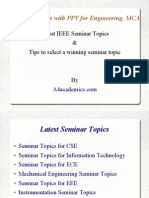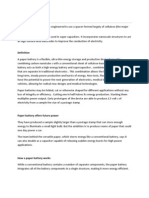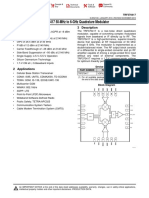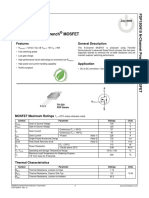100%(1)100% found this document useful (1 vote)
3K viewsSeminar Paper Battery Presentation
Seminar Paper Battery Presentation
Uploaded by
rishabh dixitThis document provides information about paper batteries. It discusses the history and invention of paper batteries at Stanford University in 2009. A paper battery combines carbon nanotubes and cellulose-based paper to create an ultra-thin, flexible energy storage device. It functions similarly to normal batteries, but uses non-toxic materials and has advantages such as lower costs, longer lifetime, and less environmental impact compared to traditional batteries. The document describes the components, working principle, applications, advantages and limitations of paper batteries.
Copyright:
© All Rights Reserved
Available Formats
Download as PPT, PDF, TXT or read online from Scribd
Seminar Paper Battery Presentation
Seminar Paper Battery Presentation
Uploaded by
rishabh dixit100%(1)100% found this document useful (1 vote)
3K views16 pagesThis document provides information about paper batteries. It discusses the history and invention of paper batteries at Stanford University in 2009. A paper battery combines carbon nanotubes and cellulose-based paper to create an ultra-thin, flexible energy storage device. It functions similarly to normal batteries, but uses non-toxic materials and has advantages such as lower costs, longer lifetime, and less environmental impact compared to traditional batteries. The document describes the components, working principle, applications, advantages and limitations of paper batteries.
Original Description:
It is a ppt on the topic paper battery
Copyright
© © All Rights Reserved
Available Formats
PPT, PDF, TXT or read online from Scribd
Share this document
Did you find this document useful?
Is this content inappropriate?
This document provides information about paper batteries. It discusses the history and invention of paper batteries at Stanford University in 2009. A paper battery combines carbon nanotubes and cellulose-based paper to create an ultra-thin, flexible energy storage device. It functions similarly to normal batteries, but uses non-toxic materials and has advantages such as lower costs, longer lifetime, and less environmental impact compared to traditional batteries. The document describes the components, working principle, applications, advantages and limitations of paper batteries.
Copyright:
© All Rights Reserved
Available Formats
Download as PPT, PDF, TXT or read online from Scribd
Download as ppt, pdf, or txt
100%(1)100% found this document useful (1 vote)
3K views16 pagesSeminar Paper Battery Presentation
Seminar Paper Battery Presentation
Uploaded by
rishabh dixitThis document provides information about paper batteries. It discusses the history and invention of paper batteries at Stanford University in 2009. A paper battery combines carbon nanotubes and cellulose-based paper to create an ultra-thin, flexible energy storage device. It functions similarly to normal batteries, but uses non-toxic materials and has advantages such as lower costs, longer lifetime, and less environmental impact compared to traditional batteries. The document describes the components, working principle, applications, advantages and limitations of paper batteries.
Copyright:
© All Rights Reserved
Available Formats
Download as PPT, PDF, TXT or read online from Scribd
Download as ppt, pdf, or txt
You are on page 1of 16
Submitted by:-
Rishabh Kumar Dixit
1531110043
B.Tech-CSE
History
Introduction
Need
Carbon Nanotubes
Properties of Carbon Nanotubes
Properties of Cellulose
Working Principle of paper battery
Applications of paper battery
Advantages of paper battery
Limitations of paper battery
In December 2009, at Stanford University, Yi
Cui and his Research Team successfully
invented the original working prototype that
provides 1.5V as its terminal voltage.
A paper battery is an ultra-thin,
environmental friendly and flexible energy
storage battery.
It is formed by combining carbon nanotubes
with a conventional sheet of cellulose-based
paper.
A paper battery acts as both a high-energy
battery and super capacitor
It is also known as nano composite battery
since it is formed from carbon nano tubes
and paper.
The Functioning of paper batteries is similar
to that of a normal chemical battery.
In normal cases, conventional batteries may
be easily damaged by corrosion.
But, the paper batteries are non-corrosive,
non-toxic and light-weight than the normal
batteries.
Paper Battery= Carbon Nanotubes + Cellulose
(Paper)
The ordinary electro-chemical battery faces many
problems such as:-
Limited Lifetime:- The primary batteries can’t be
recharged. Although the secondary batteries can
be recharged, the lifetime may be very short. So,
paper batteries provide a longer lifetime.
Costlier:- Secondary batteries are much costlier
than the paper batteries.
Environmental Influence:- The extensive use of
batteries can generate environmental pollutions
like toxic metal pollutions etc. But, the paper
batteries are environment friendly and can
decompose very easily.
Leakage:- If by chance any leakage of
batteries occurred, the chemical may be very
dangerous to the environment and also to the
nearby metals which are in contact with the
batteries. But, there is no toxic chemical
present in the paper batteries.
Carbon nanotubes (CNTs; also known as buckytubes)
are allotropes of carbon with a cylindrical nanostructure.
They exhibit extraordinary strength and
unique electrical properties, and are efficient thermal
conductors.
Nanotubes are members of the fullerene structural family, the
diameter of a nanotube is on the order of a few nanometers
Because of the symmetry and unique electronic structure of
graphene, the structure of a nanotube strongly affects its
electrical properties. For a given (n,m) nanotube, if n = m, the
nanotube is metallic; if n − m is a multiple of 3, then the
nanotube is semiconducting with a very small band gap,
otherwise the nanotube is a moderate semiconductor.
Carbon nanotubes are flexible and very light-
weight.
Carbon nanotubes offer high tensile strength.
Carbon nanotubes are good conductors of
electricity.
Carbon nanotubes have high packing density
and low mass density.
Carbon nanotubes provide low resistance.
Cellulose is a bio-degradable an bio-
compatible material.
Cellulose provides low shear strength.
Cellulose offers high tensile strength.
Cellulose has magnificent absorption capacity
and porosity.
Cellulose can be easily recycle and reused.
Cellulose is non-toxic.
The internal performance of paper batteries is identical to that
of a traditional battery. We can recall the working principle of a
traditional battery where ions(positively charged particles) and
electrons(negatively charged particles) move between the
electrodes i.e., anode(positive electrode) and cathode(negative
electrode). Due to the flow of electrons from cathode to anode,
current starts flowing from anode to cathode along the
conductor.
Cathode:- Carbon Nanotube.
Anode:- Lithium metal(Li+).
Electrolyte:- Bio electrolyte like blood etc.
Separator:- Cellulose or paper.
Similarly in paper batteries, the metal(lithium) is used
as the anode and carbon nanotube as cathode and also
the paper or cellulose is used as the separator. Due to
the chemical reaction between the electrolyte and the
carbon, electrons are generated. Similarly, due to the
chemical reaction between the electrolyte and metal,
ions are generated. These generated electrons starts to
flow through the external circuit from cathode to
anode.
Paper Battery can be implemented in wearable
technology.
Paper Battery can be used in entertainment
devices.
Paper Battery can be used in smart cards.
Paper Battery can be used for medical
applications like disposable medical diagnostic
devices.
Paper Battery can also be used in pacemakers
due to its non-toxic and biodegradable nature.
Paper Battery is ideal for aircraft, automobiles,
remote controllers etc.
Paper Battery can be used as both a super
capacitor and a battery.
Paper Battery is very flexible, ultra-thin, non-
toxic, bio-degradable and a longer life-time.
Paper Battery provides a steady power.
Paper Battery can be available in different shapes
and sizes.
Paper Battery offers high energy efficiency.
Paper Batteries are low in cost and can be easily
disposed.
Paper Battery can be used to produce 1.5V
energy and are rechargeable.
The construction of carbon nanotubes used
in the paper battery is very expensive. There
are different techniques used like chemical
vapor deposition(CVD), Arc discharge,
electrolysis, laser ablation etc.
If we inhaled the paper battery, they start
interacting with the microphages present in
the lungs. This is very similar to the same of
asbestos fibers, so, it will be very hazardous
for the health of humans.
THANK YOU!!!
You might also like
- Internship Report On Embedded System and IoT Technology.Document72 pagesInternship Report On Embedded System and IoT Technology.manish82% (11)
- Synopsis On Paper BatteryDocument4 pagesSynopsis On Paper BatteryRahul Garg0% (1)
- Seminar Report PAPER BATTERY (2016-20)Document24 pagesSeminar Report PAPER BATTERY (2016-20)Waquar Ahmad90% (20)
- E Paper Seminar ReportDocument27 pagesE Paper Seminar Reportvrushali kadam100% (2)
- E-Paper Technology DocumentDocument32 pagesE-Paper Technology DocumentZuber Md54% (13)
- NANOELECTRONICS 1 (2) Seminar ReportDocument31 pagesNANOELECTRONICS 1 (2) Seminar ReportPramod RoyNo ratings yet
- ch19 Two-Port Networks PDFDocument19 pagesch19 Two-Port Networks PDFRohit Gandhi50% (2)
- Seminar Report-Paper BatteryDocument20 pagesSeminar Report-Paper BatteryRuchik Biniwale100% (3)
- Paper BatteryDocument16 pagesPaper BatterypiyushNo ratings yet
- Paper Battery Seminar Report PDFDocument21 pagesPaper Battery Seminar Report PDFSavita Hanchinal100% (1)
- Paper BatteryDocument27 pagesPaper BatteryAmbuj Maurya100% (1)
- Self-Rechargeable Paper Thin Film Batteries Performance AND ApplicationsDocument34 pagesSelf-Rechargeable Paper Thin Film Batteries Performance AND Applicationskrishnamalhotra1993No ratings yet
- Paper Battery AbstractDocument3 pagesPaper Battery AbstractBharat Chattarki50% (4)
- Report On Bio BatteryDocument30 pagesReport On Bio BatteryHimanshu Raj100% (3)
- Report On IOT and Embedded SystemsDocument39 pagesReport On IOT and Embedded SystemsAyushNo ratings yet
- E PaperDocument29 pagesE PaperSudheesh Vs100% (2)
- E PaperDocument22 pagesE PaperSrajit Saxena100% (6)
- Electronic Skin My PresentationDocument22 pagesElectronic Skin My PresentationJayalekshmi Sivan92% (24)
- Paper Battery Full Seminar ReportDocument19 pagesPaper Battery Full Seminar ReportAayushi Vijh75% (8)
- Seminar ReportDocument21 pagesSeminar ReportVishnu100% (1)
- PolytronicsDocument14 pagesPolytronicsEasy Study92% (12)
- Role of Microcontroller in Embedded System MarketDocument3 pagesRole of Microcontroller in Embedded System MarketAbhishek Abhi100% (4)
- CN Lab ManualDocument49 pagesCN Lab ManualKN DEEPSHI100% (1)
- Seminar Report On Paper BatteryDocument40 pagesSeminar Report On Paper BatteryabhijeetNo ratings yet
- Ieee Paper BatteryDocument1 pageIeee Paper Batteryanishkalra08100% (1)
- Full Report On "VEHICLE TO GRID TECHNOLOGY (V2G) "Document35 pagesFull Report On "VEHICLE TO GRID TECHNOLOGY (V2G) "Rahul Garg67% (3)
- Project Report On Heartbeat MonitoringDocument28 pagesProject Report On Heartbeat Monitoringbagdeparag96% (28)
- Seminar Report Organic Light Emitting DiodeDocument23 pagesSeminar Report Organic Light Emitting DiodesaRAth asgaRdian100% (3)
- IoT Module-4 NotesDocument3 pagesIoT Module-4 Notessachin m100% (3)
- Viva QuestionsDocument12 pagesViva QuestionsJayesh Tanwani50% (4)
- Best Seminar Topics WithDocument16 pagesBest Seminar Topics WithGeorge John50% (4)
- Seminar Report On E-PaperDocument18 pagesSeminar Report On E-PaperWajahat Nasim90% (10)
- Renewvable Sources Seminar ReportDocument16 pagesRenewvable Sources Seminar ReportSanketDhande100% (3)
- Seminar Report On Super CapacitorsDocument21 pagesSeminar Report On Super Capacitorsshramahrsht89% (9)
- Paper Battery: A Seminar Report OnDocument16 pagesPaper Battery: A Seminar Report OnSaawan HiwaleNo ratings yet
- Eskin Seminar ReportDocument17 pagesEskin Seminar Reportsai kiran75% (8)
- Smart Grid Technology Seminar ReportDocument36 pagesSmart Grid Technology Seminar ReportSwamy Jagari67% (3)
- VTU Exam Question Paper With Solution of 18EE51 & 17EE51 Management and Entrepreneurship Jan-2021-Santosh KathariDocument17 pagesVTU Exam Question Paper With Solution of 18EE51 & 17EE51 Management and Entrepreneurship Jan-2021-Santosh KathariSupritha100% (1)
- Final Intrenship ReportDocument32 pagesFinal Intrenship Report046 KISHORE33% (3)
- Report On OrCADDocument49 pagesReport On OrCADShivam Gautam100% (5)
- Bio BatteryDocument18 pagesBio BatteryMaruthi Doradla100% (2)
- Ultracapacitor Seminar ReportDocument23 pagesUltracapacitor Seminar ReportDigvijay Singh100% (1)
- Plastic Solar Cell Technology: Submitted To: - Submitted byDocument37 pagesPlastic Solar Cell Technology: Submitted To: - Submitted bynavya80% (5)
- Seminar ReportDocument23 pagesSeminar ReportSwapnil Behera100% (1)
- Paper BatteryDocument2 pagesPaper BatteryJeswanth KumarNo ratings yet
- Seminar Report: Electrical Engineering Suraj Patel ROLL NO-1605420042Document23 pagesSeminar Report: Electrical Engineering Suraj Patel ROLL NO-1605420042Shafahad Ansari100% (1)
- Subsystem Design: Architectural IssuesDocument26 pagesSubsystem Design: Architectural IssuesSanjana M PNo ratings yet
- Seminar Report On Embedded System in AutomobilesDocument21 pagesSeminar Report On Embedded System in AutomobilesJobin Philip Varghese71% (7)
- Flexible Electronic Skin (Modified)Document18 pagesFlexible Electronic Skin (Modified)maheshfbNo ratings yet
- Final Seminar ReportDocument30 pagesFinal Seminar Report046 KISHORE100% (5)
- Piezo Literature ReviewDocument7 pagesPiezo Literature ReviewEngineering ProjectNo ratings yet
- Report of Infrared Plastic Solar CellDocument22 pagesReport of Infrared Plastic Solar CellAjay Mv85% (54)
- Presented By-Adves 8 (B) ROLL No - 277Document33 pagesPresented By-Adves 8 (B) ROLL No - 277babloo2220No ratings yet
- Paper BatteryDocument7 pagesPaper Batterybasu33No ratings yet
- Paper Batteries: P B: P W T EDocument14 pagesPaper Batteries: P B: P W T ELaxmanpallai PallaiNo ratings yet
- Paper Batteries: Paper Thin Power: N A I D: A T DDocument7 pagesPaper Batteries: Paper Thin Power: N A I D: A T DNikhil GoptrNo ratings yet
- Presented by B.SANJAY KUMAR 11261A04C9Document11 pagesPresented by B.SANJAY KUMAR 11261A04C9Mohan RajNo ratings yet
- Paper Batteries: Paper Thin Power: Sheikh RoufDocument7 pagesPaper Batteries: Paper Thin Power: Sheikh RoufESS ROUFNo ratings yet
- Presented by Apurva Nandan 107459 E4Document11 pagesPresented by Apurva Nandan 107459 E4Gayathri SNo ratings yet
- Presented by Apurva Nandan 107459 E4Document11 pagesPresented by Apurva Nandan 107459 E4Nanda KishoreNo ratings yet
- Journal Paper BatteryDocument5 pagesJournal Paper BatteryNee AbhimaniNo ratings yet
- Typical X To R RatioDocument2 pagesTypical X To R Ratioberto_diego0% (1)
- Influence of Parasitic Resistances On The Input ReDocument16 pagesInfluence of Parasitic Resistances On The Input ReEduardo RodriguesNo ratings yet
- Multiple Choice QuestionsDocument3 pagesMultiple Choice QuestionsNaheedNo ratings yet
- Juniper M320 Hardware GuideDocument338 pagesJuniper M320 Hardware GuideLeon AleNo ratings yet
- 2syoon SSLMB Synthesis Paper Weebly WebsiteDocument30 pages2syoon SSLMB Synthesis Paper Weebly Websiteapi-669972017No ratings yet
- D BatuDocument1 pageD BatuAnonymous I13s99No ratings yet
- 6th Semester - CourseDocument4 pages6th Semester - CoursePratikNo ratings yet
- WTB4-3P2162: Miniature Photoelectric SensorsDocument6 pagesWTB4-3P2162: Miniature Photoelectric SensorsJefferson BentesNo ratings yet
- Capacitor Contactors Benedict JägerDocument12 pagesCapacitor Contactors Benedict Jägermv1970No ratings yet
- Bedienungsanleitung User Manual Manuale D'Uso Manuel de L'UtilisateurDocument2 pagesBedienungsanleitung User Manual Manuale D'Uso Manuel de L'Utilisateurmich2767No ratings yet
- Manual SWING 61 Double Relay 29224-EN 120418Document40 pagesManual SWING 61 Double Relay 29224-EN 120418Fredy TorresNo ratings yet
- 1 Electrostatics-Theory PDFDocument39 pages1 Electrostatics-Theory PDFanup vermaNo ratings yet
- #All About RelayDocument10 pages#All About RelayRitika Jain100% (1)
- VLSI Design of Low Power Reversible 8-Bit Barrel ShifterDocument6 pagesVLSI Design of Low Power Reversible 8-Bit Barrel Shiftereditor_ijtelNo ratings yet
- trf370417 InformationDocument35 pagestrf370417 InformationChandrashekhar KulkarniNo ratings yet
- Block Diagram Rdenca412Wjqz: PowerDocument3 pagesBlock Diagram Rdenca412Wjqz: PowerMohamed ElbanadiNo ratings yet
- The CMOS Inverter: Slides Adapted From: N. Weste, D. Harris, CMOS VLSI Design,, 3/e, 2004Document27 pagesThe CMOS Inverter: Slides Adapted From: N. Weste, D. Harris, CMOS VLSI Design,, 3/e, 2004Priyanka AshishNo ratings yet
- MHD Power GenerationDocument16 pagesMHD Power GenerationRohan Sharma79% (14)
- SynthesisDocument51 pagesSynthesissudhir100% (2)
- DRG, For Grid Resistance BoxDocument7 pagesDRG, For Grid Resistance BoxSANJAY DEOPURANo ratings yet
- FDP 150 N 10Document8 pagesFDP 150 N 10Luka BaracNo ratings yet
- Dual Source Meter EM 9024Document2 pagesDual Source Meter EM 9024ilaaNo ratings yet
- Online - Bai 2 - Mach Ban DanDocument15 pagesOnline - Bai 2 - Mach Ban DanThất VọngNo ratings yet
- UT Dallas Syllabus For Phys2422.001.11f Taught by Yuri Gartstein (Yxg037000)Document5 pagesUT Dallas Syllabus For Phys2422.001.11f Taught by Yuri Gartstein (Yxg037000)UT Dallas Provost's Technology GroupNo ratings yet
- Stand Alone PV Systems PDFDocument244 pagesStand Alone PV Systems PDFm_asifNo ratings yet
- DELAPUERTA - Lesson Plan in Physics.Document12 pagesDELAPUERTA - Lesson Plan in Physics.Marinella Cudo DeLa PuertaNo ratings yet
- PDF Electric Circuits 1st Edition James S. Kang - eBook PDF downloadDocument51 pagesPDF Electric Circuits 1st Edition James S. Kang - eBook PDF downloadpulataekki100% (3)
- Entraco-Bks Busduct Pvt. LTD.: Packing List ForDocument1 pageEntraco-Bks Busduct Pvt. LTD.: Packing List ForsubhajiyroyNo ratings yet
- Radio Craft 33 Amplifier Builder's GuideDocument68 pagesRadio Craft 33 Amplifier Builder's GuidemplennaNo ratings yet

























































































